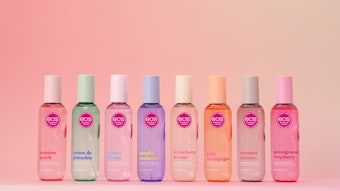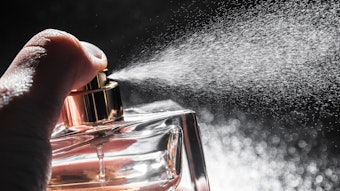Editor’s note: This article originally ran in the February 2014 issue of Perfumer & Flavorist magazine. Reprinted with permission, and all rights reserved.
“It’s an exciting time to create fragrances,” says Mane perfumer Ashley Wilberding Balavoine, reflecting the dynamism and growth potential of the personal care category. The personal care products category boasts more than $250 billion in annual sales, according to the Personal Care Products Council (PCPC), driven by consumers’ desire “to live better, healthier lives.”
Meanwhile, Euromonitor International values the 2013 global bath and body care market at $55 billion, an increase of approximately 7% over 2012. According to a Euromonitor report, beauty and personal care in the United States are expected to grow through 2017 in response to premium and value-added products, and hair care and skin care innovations for aging populations.
Indeed, the personal care category, which for the purposes of this article includes products such as soaps, shower gels, shampoos and deodorants, is experiencing growth due to key emerging markets, product innovations and evolving consumer needs.
Rethinking Emerging Markets
In late 2013, Unilever told Agence France Presse that demand in emerging markets, which account for more than half of the company’s sales, had weakened. In addition, a company spokesman noted that ongoing growth in these markets would drop from the expected 5% to somewhere between 3.0% and 3.5%. Despite this, Rob Walker of Euromonitor International, writing for P&F sister publication GCI magazine, explained, “In 2013, for the first time ever, consumers in emerging markets will collectively spend more on bath and body care products than consumers in developed markets… A decade ago, developed markets accounted for nearly 70% of worldwide bath and body care sales.”
However, he said, the geographic focus is shifting. While Latin American market results come under negative pressure in Brazil, Argentina, Venezuela and Mexico, the fastest growth will be seen in Africa and the Middle East. While some of these markets may be high-risk, Walker noted that consumer product companies must diversify the emerging markets served to secure ongoing growth.
The Global Natural Boom
Interestingly, Brazil and China are key drivers of the $29.5 billion natural personal care market, reports a 2013 Kline & Co. market brief. The global natural personal care market has experienced a compound annual growth rate of 11.3% over the last five years, according to Kline, and could reach $46 billion by 2018. In Brazil, 85% of the market is dominated by domestic giants Natura and O Boticario, with ingredients falling across a broad spectrum of synthetics, naturals and organics.
“Within the flourishing Chinese market, while both domestic and foreign brands are enjoying growth, domestic ones still claim an estimated 80%-plus share of the market,” said Zachary Ferrara, Kline’s project lead in China. “Notably, of these local players, those offering mostly TCM (traditional Chinese medicine) products account for approximately less than two-thirds of the Chinese natural personal care market. However, international natural brands are becoming more accepted by Chinese consumers as they are considered to be of a higher quality.”
In a separate analysis, Kline’s Nancy Mills said, “In 2013, the Chinese natural personal care is posting growth of almost 25%, fueled by a cultural reliance on Traditional Chinese Medicine (TCM), increased—confidence-inspiring—transparency in product safety and health related matters, and growing affluence.”
On the other hand, the 7% U.S. growth and 6% European growth in natural personal care in 2013 has been driven by brand diversity, product efficacy, price and a desire for greater labeling transparency. Kline notes that Japan’s natural personal care market grew 5% in 2013, driven by shampoos, conditioners and personal cleansing products.
Natural positioning is desirable for manufacturers around the globe, and many products are being reformulated to remove or minimize synthetic components. Of course there are price, performance and olfactory sophistication issues to consider when selecting ingredients.
A 2013 Euromonitor U.S. beauty and personal care report notes, “The multitude of complex chemical compositions in today’s beauty and personal care products rivals only modern consumers’ collective ignorance surrounding their use. According to a 2009 poll of 2,016 participants by natural deodorant company Bionsen, the average woman uses 515 different synthetic chemicals on herself each day, with only 9% aware of what most of the key ingredients actually were.”
Presumably, consumer awareness of the ingredients contained within their products has only increased, even as growing amounts of naturals, notably argan oil in hair care, are incorporated into product designs as their efficacy improves. Yet, even as product developers and formulators create products with marquee ingredients, many are also highlighting what’s not in the bottle. Notably, Unilever’s Simple skin care line, which underscores its fragrance-free status in marketing communications.
“People [consumer product companies] are interested in essential oils,” says perfumer Balavoine. “But they don’t know quite how to use them in their formulations. They’ll say ‘we want 100% essential oils,’ or they’ll say they want to claim essential oils on their label. Or they don’t want to have ‘fragrance’ on their label. They want to be able to explain the whole formula on the label using only essential oils. It’s a challenge for [perfumers]. It presents a lot of limitations to a wonderfully wrapped fragrance when [you’re] limited to essential oils or 100% natural because the formula has to be short, and those ingredients need to fit on a small label. I think it’s extremely challenging, especially when you’re talking about sourcing, price and quality fluctuations year-to-year.”
As a perfumer, Balavoine has access to natural fair trade ingredients, including Mane’s Namibian myrrh. “People [customers] are looking for fair trade ingredients,” she says, which offers an ethical and competitive advantage.
However, she notes, the palette is still limited, though growing, based on partnerships with local growing communities that require time to develop. “Fair trade is not a quick flip of the button,” she says. “It’s a long-term opportunity.”
Still, Balavoine says, she enjoys formulating with natural fragrance materials and, working closely with customers, is able to successfully create to product specifications.
Meanwhile, Rafael Trujillo, research fellow perfumer at Procter & Gamble, says, “We’re seeing a lot of ingredient-based fragrances that we match with the holistic design of a product. As a perfumer I need to be on top of what’s trending in terms of ingredients, combinations, and how my perfume is going to help drive the end benefit of the products we’re designing.”
For example, he points to the recently released Herbal Essence naked line of shampoo, conditioner, dry shampoo, volumizer and flexible-hold spritzer products. The line touts the absence of parabens, silicone and dyes in the formulations, which include white grapefruit and mint extracts. The line’s scent includes notes of citrus, peach blossom, guava, mint and jasmine.
“That’s the holistic proposition,” says Trujillo. “When you see the bottle, you see the message, the fragrance is important to support it. I see a lot of integration of the different elements of the product with the fragrance.”
Trujillo continues, “There’s a group of consumers that’s as interested in what’s not in the product, as what is. They want a product that will do the job and will meet specific compositional needs.” He adds, “I am not creating fragrances that are too simplistic. The consumer still wants the experience of the fragrance to meet their specific needs.”
Innovations in Men’s Grooming
Men’s grooming accounted for 8%, or $34 billion, of the total personal care and beauty market in 2012, driven by a small but rapidly growing skin care segment, according to Euromonitor analysts. In 2013, the markets of the United States, United Kingdom, India, China and Germany presented growth opportunities.
According to Euromonitor’s Walker, “In 2012, sales of bath and body care products in India grew by 15%, with men fueling a big share of the spending. India’s market is characterized by youthfulness—the median age is 26. There is also a mushrooming and economically empowered middle class with an appetite for global brands.”
“We’re working more in men’s grooming,” says Balavoine. “It’s an interesting category and a challenge because how do you do a great-testing fragrance for men that doesn’t smell like fougère? It’s got to burst out of the bottle, and I think there’s room in men’s grooming for more variety.” In the future, she says, men’s grooming scents could comprise citrus, oriental and floral scents, even in the United States, provided they aren’t overtly sweet.
Personal Care for an Aging Population
Euromonitor’s Walker notes that baby boomers are a ripe target for tailored and multifunctional products, inevitably leading to cross-pollination among beauty and personal care categories. Examples include Dove’s Men + Care, L’Oreal’s Serie Expert Age Supreme and Pantene’s Age Defy lines.
Increasingly, says Balavoine, aging consumers will seek products that address their unique hair, skin and body care needs, including hair-thickening and vitamin-added offerings. Unlike younger consumers they may not be attracted to trendy fragrance profiles like acai, so perfumers will be charged with incorporating scents that match brands and demographics.
Trujillo adds, “We continue to explore new benefits, new spaces. Aging is a big concern in today’s society.”
Echoing Balavoine’s comments, he says that in designing anti-aging products, specific fragrances must be incorporated into the formula for coherency of message and performance.
Trujillo concludes, “My job as a perfumer is to develop fragrances that support the benefit the product is intended to [deliver.] When you do it right, the consumer ‘gets’ it.”
Technology-Driven Benefits
“Manufacturers of deodorants over the past five years have increasingly aligned them with fragrances, launching body spray versions of their most popular scents and even bringing in famous perfumers to formulate the scents,” explains Euromonitor analyst Nicole Tyrimou in a recent market report. “As competition with mass fragrances has intensified, men’s deodorant brands have been extended into men’s bath and shower and hair care, with examples including the recent introduction of Axe Apollo, which consists of a body spray, deodorant stick, and shampoo and shower gel.”
Beyond scents, fragrance and product formulators are focusing on added technologies in antiperspirants and deodorants. “I continue to see a need in this category for technology driven benefits like malodor removal,” says Trujillo.
The success of products such as Secret Clinical Strength and the recently launched Secret Stress Response offer illustrations of this trend, he notes. Formulating for these types of products requires formulators to understand the key consumer touchpoints, Trujillo explains, and to develop systems that deliver the right benefit at the right time for the necessary duration.
He continues, “In antiperspirants, consumers continue to tell us they want more malodor efficacy when they need it the most. So we have to design our fragrances accordingly and [apply] technologies to deliver those fragrances where they need them and when they need them.”
Fragrance Trends: Relatable Ingredients
To pursue “trend-based holistic innovation” requires perfumers and product developers to understand how consumers are changing and how their perspectives are reshaped by societal changes, foods, beverages, etc.
A Euromonitor U.S. personal care and beauty report notes, “By using relatable ingredients, including those more often associated with foods, companies are able to promote products that are not only safer alternatives, but healthier ones. The common thought process here is that ingredients that are good enough to go in one’s body must surely be suitable for going on one’s body.”
As a perfumer, Balavoine keeps an eye on what’s happening in the beverage category to stay on top of breaking trends. “We have demand for fragrances that smell like superfruits [pomegranate, acai, berries etc.],” she explains. “People are drinking those superfruit juices for their health, so people are looking for fragrances that deliver that [impression]. There are other fruits that you’ll find in beverages that are crossing over to fragrances … like dragonfruit or a lychee or a starfruit that create a fantasy smell around a flavor.”
She adds, “Our customers are interested in the food and beverage inspiration, such as honey. Our customers are interested in using honey in new and different ways… because it’s really popular in food.
Recent examples in scent include Bath & Body Works Honey Sweetheart, Marc Jacobs Honey and Pure Honey Kim Kardashian. Balavoine, who trained in the South of France and has spent time developing fragrances in China and Mexico, says any discussion of fragrance trends is tempered by local or regional specificities.
“I’m inspired from market to market,” she says. “Trends are specific to cultures [but] globalization is occurring in fragrance—there’s a little in personal care.”
While fruity and green scents may be applied to products around the world, she says the profile may tend toward apple in one market, but veer toward cucumber or melon in another.










